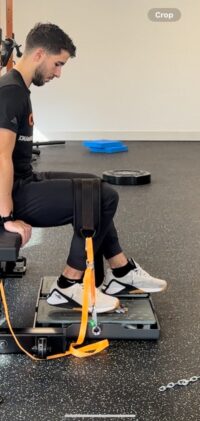I’m now at that age where I have to start being more mindful of the nagging calf and Achilles injuries that seem to pop up for so many of us in our 30s, 40s, and beyond. Whether it’s rec league basketball, tennis, pickleball, or just hitting the gym hard, many active adults still love to move with intensity—but we may not have the same resiliency we had in our 20s.
At Cohen Health and Performance, we see it all the time in our physical therapy clinics: a fit, active individual suddenly sidelined by a calf strain. These types of injuries tend to be the first warning sign of lower leg issues that can creep up when we push our bodies beyond what they’re currently prepared to handle.
Why Calf Injuries Happen
A calf strain typically occurs when the loading tolerance of the muscle—its ability to handle force—is exceeded. It’s not always about being out of shape; in fact, many of our patients are in great cardiovascular condition. But if the calf and Achilles haven’t been progressively trained to handle specific types of force—like running, jumping, or quick direction changes—they’re vulnerable.
One of my patients recently told me they went on vacation and, without access to a gym, decided to start running more than usual. They felt fit, so why not? But shortly after, they messaged me with a calf strain. Their cardiovascular system may have been ready—but their calf muscles weren’t conditioned for that repetitive impact. That mismatch between perceived fitness and actual tissue readiness is a common reason we see these injuries in our physical therapy practice.
Physical Therapy for Calf and Achilles Recovery
So what do we do when a calf injury strikes? Or better yet—how can we prevent it?
The key lies in a progressive, personalized rehabilitation plan, and physical therapy plays a critical role in that process. Here’s how we typically approach it:
1. Start with Isometric Loading
We begin with isometric exercises, where the muscle contracts without changing length. This is a safe, low-threat way to begin reactivating the calf muscle after injury. Isometrics help reduce pain, improve blood flow, and reintroduce loading to the tissue without overstraining it. These are often the first steps in any effective physical therapy plan for a strained calf. For more information on isometric exercises, check out this article and video!
2. Progress to Full Range of Motion Drills
Next, we move into more dynamic exercises that take the muscle through a full range of motion. The calf needs to be able to both shorten and lengthen under load, especially if you want to return to activities like running or jumping. These movements are carefully progressed based on how the tissue responds.
3. Introduce Plyometric and Sport-Specific Drills
Once strength and mobility are restored, we introduce plyometric exercises to recondition the tissue for faster, more explosive movements. At this stage, we might use bands or assistance tools to reduce body weight until you’re ready to go full intensity.
Finally, we tailor the program to your sport or activity. Runners may progress to drills like A-skips and A-runs, while basketball or tennis players might focus on reactive jumping or lateral movement training.
Personalized Care is Key
No two injuries—or recoveries—are the same. That’s why every physical therapy plan at Cohen Health and Performance is built around your unique goals, limitations, and lifestyle. Whether you’re returning to a sport or just want to stay pain-free during weekend workouts, we’re here to help you move forward.
If you’ve recently dealt with a calf or Achilles injury—or you’re hoping to prevent one as you stay active into middle age—we’d love to help. Our physical therapy team specializes in helping active adults recover quickly, move better, and keep doing what they love.
Contact us to schedule your evaluation at our Bethesda or McLean location. Don’t let a nagging calf injury slow you down.
